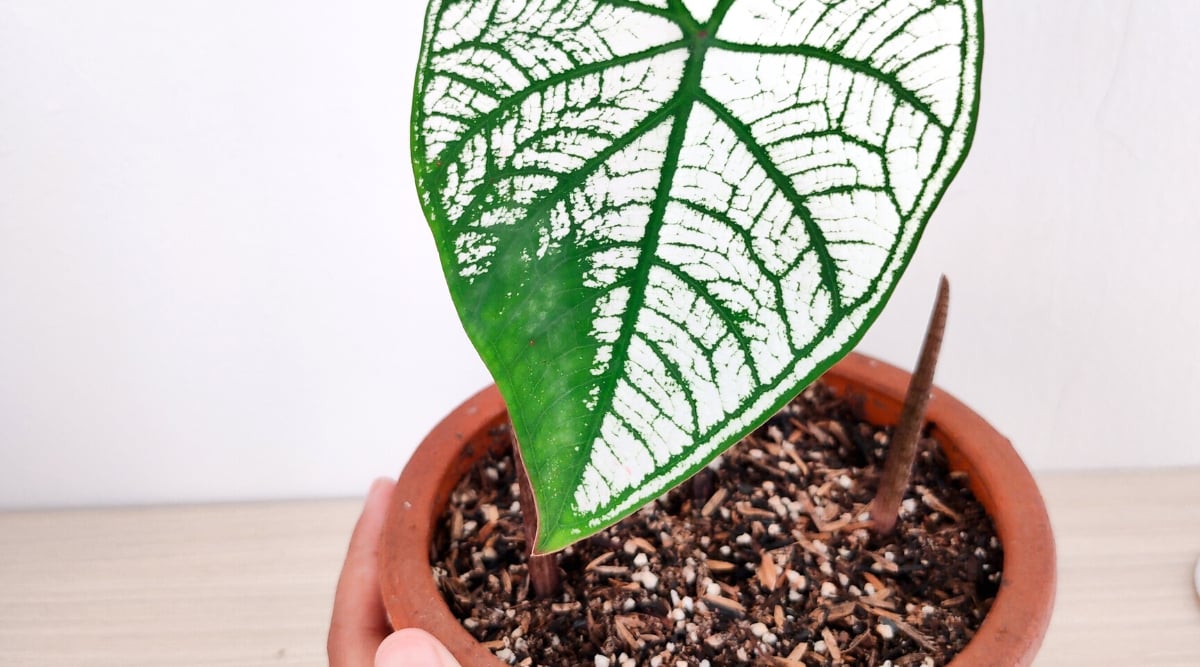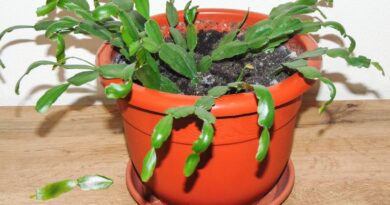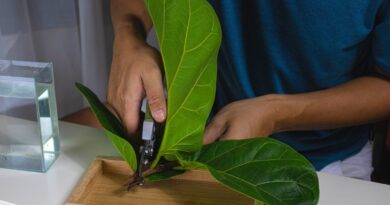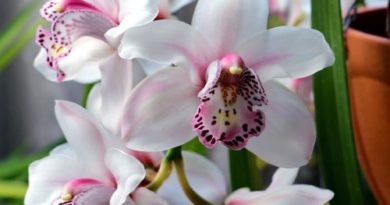How to Plant, Grow, and Care for White Christmas Caladium
Though we associate it with snowy, northern winters because of its color scheme and cultivar name, Caladium ‘White Christmas’ is actually a tropical plant with firm roots in the southern hemisphere. Ironically, it has no tolerance for frost and demands a substantial amount of heat and humidity.
Perennial in zones 9 to 12, this variegated caladium can be left in the ground year-round in those climates or grown as an annual plant in cooler regions. It’s also a container garden staple, a cheerful houseplant, and a popular holiday gift.
Read on for a full breakdown of this caladium cultivar, including its history, growing preferences, maintenance requirements, and problem areas.
.0Overview

|
|
|
|
Characteristics

‘White Christmas’ is appreciated mainly for its foliage, shaped like an elongated, pointy heart, and droops slightly from a central bouquet of tuberous stems. Leaves are primarily white with complex, dark green veins radiating from their midribs and margins. Plants usually average between 1 and 2 feet tall and prefer indirect sunlight.
Though the plant does produce small, calla-like flowers called ‘spathes’ throughout the summer, there will be very few, and they are considered insignificant. Usually white or light pink, they emerge as a spike near a plant’s crown at 6 to 8-week intervals. Seasoned gardeners usually remove buds when they appear, so plant energy can be directed at creating big, beautiful leaves rather than nourishing a modest inflorescence.
Caladiums grow from tuberous corms and require soil with good drainage, or they will rot. Whether grown perennially outside, brought in for winter, or kept as a houseplant, all caladium plants have a leaf cycle that lasts roughly 20 weeks. After this cycle is complete, plants go through a period of dormancy where leaves will fade or die and roots will rest.
History & Cultivation

The first known species in the Caladium genus were discovered in South and Central America in the 1700s. As members of the Arum family (Araceae), caladium plants were native to the rainforest floor where the sun was dappled and the humidity high.
Later in the century, botanists brought samples to Europe, where plants were appreciated for their oversized foliage and shade tolerance. As demand for the plant grew, botanists began experimenting with the genus to create thousands of new cultivars from roughly 20 original species.
This cultivar experienced a rapid rise in popularity due to its versatility, companionship possibilities, and seasonal appeal. Today, you might see it called ‘Angel Wings’ or ‘Elephant Ears’ in garden centers and online catalogs, but Caladium x hortulanum ‘White Christmas’ is the plant’s actual name.
Planting

This plant will not survive in temperatures below 65 degrees Fahrenheit and is often kept as a houseplant. Though planting rules and techniques will vary depending on location and usage, keep this minimal temperature need in mind, and you’ll be off to a good start.
The second universal caladium requirement is good drainage. Whether you grow it as a perennial, an annual, or a houseplant, ensure it never experiences oversaturation and dries out completely between waterings.
After these priorities have been met, planting techniques will vary a bit. Here’s a look at how to plant it in the ground and in containers.
Seeds

Because this cultivar is a hybrid caladium, seeds harvested from its flowers will likely revert to one or the other parent plant species and will not produce a true ‘White Christmas’ plant.
‘True to type’ seeds can be purchased and started indoors, but sprouts are fragile and difficult to establish. For best results, plant corms should be purchased from a reputable grower.
Corms

In zones 9 through 12, plant directly in the ground in spring or fall. Temperatures will be mildest during these shoulder seasons, and you will not have to water as often. Select a location with partial to full shade that slopes downward and/or drains thoroughly, and follow these steps:
- Dig a hole roughly 2 to 3 times the corm’s height.
- Additional holes should be 10 to 12 inches apart.
- Be sure the ‘eyes’ or ‘shoots’ are pointing upward and the flat, hairy end sits in the base of the hole.
- Backfill with soil and tamp down gently.
- Keep moist by watering lightly until green growth emerges roughly three weeks later.
In zones below 9, corms should be started inside in pots roughly 6 to 8 weeks before you expect to plant them outside. Since the optimal soil temperature for planting is 65 degrees, this means different timing in different parts of the world.
The rules for ground planting are similar to container planting, but there are a few additional steps:
- Select a container with 3 to 5 drainage holes that are clean and free-flowing.
- Use a soil mix designed specifically for potted plants.
- If caladiums are to be transplanted within a month or two, they can be spaced 3 to 4 inches apart rather than 10 to 12.
- Plant corms at a depth of 2 to 3 inches with ‘eyes’ pointing upward.
- Backfill loosely with the potting medium.
- Keep soil moist without overwatering until green shoots break the surface.
- When outdoor temperatures are optimal, transplant shoots outside following the rules for direct planting (above).
Established Plants

If you purchased or are transplanting a caladium plant that is already leafed out and has an established rootball, the rules will be slightly different. Here are the steps for planting a plant purchased from a garden center or excavated from another location:
- Select a site or container with good drainage.
- Measure the height of the rootball from bottom to crown and the width from side to side.
- Dig a hole that’s about two inches shorter than the rootball’s height and roughly two to three times its width.
- Remove the caladium from its original container and set it in the hole so that its crown sits slightly above soil level.
- Backfill the hole with soil and tamp down lightly around the plant’s base.
How to Grow
This caladium is fairly easy to grow if you meet its light, water, and soil preferences. Remember that it will experience a dormant cycle at roughly 20-week intervals, and don’t panic if it drops its leaves or loses its vibrancy every so often.
Here are the basic growing requirements to follow for a healthy, happy ‘White Christmas’ in your yard or on your counter.
Light

This is a partial to full-shade plant and grows best in locations with less than four hours of direct exposure to the sun per day. Excessive amounts of direct light will cause leaves to burn, brown out, or shrivel, particularly if exposure occurs in the late afternoon. Plant or locate it where rays will be concentrated in the morning.
When planting this cultivar in the ground or a container that will remain outside, locate your caladium beneath the canopy of a mature tree or in the shade of a tall building. Indoors, place your potted plant in a north or east-facing window where direct light will be minimalized, but the room is still bright.
Water

This species has average water requirements and prefers evenly moist soil. Check the surface soil every couple of days to see if it’s dry, and provide an inch or so when it dries out completely. In cooler months, this might mean watering two or three times a week. In warmer months, it might mean every other day. Use a soil moisture reader if you are unsure how much your caladium needs.
Use the same watering guidelines for indoor plants, considering variables like heating elements and room humidity when assessing moisture needs. Take care not to flood the soil. Since they have tuberous roots, these plants are susceptible to root rot and should never be saturated.
Stop watering indoor and outdoor caladium plants when leaves fall off or turn brown. This signals that they are entering dormancy and will not be taking up water. Resume regular watering when new growth emerges.
Soil

Caladiums grow best in soil that’s neutral to slightly acidic, ideally with a pH somewhere between 5.5 and 6. When planting in a container, use a balanced potting medium; the pH should be near-ideal.
If you don’t know your soil’s basic makeup, purchase a test kit online or at your local garden center. This will let you know if it needs to be amended. If a deficiency is revealed, work in some compost or other organic material to boost acid levels naturally.
Well-draining soil is also crucial to the health and longevity of your plant. Loose, crumbly dirt rich in organic material provides the best environment for root growth and disease prevention.
Dense or clay-like soil will hold water too long and expose plants to moisture-related problems. Add sawdust, peat moss, or mulch to the soil to improve drainage, preferably well before planting time.
Fertilizing

This is not a particularly aggressive feeder. However, indoor and outdoor plants benefit from a fertilizer application once a month during periods of active growth.
Choose a balanced ratio of nitrogen to phosphorus to potassium for bright, colorful leaves and healthy roots. Follow product instructions and repeat as directed. Pause feedings when your plant enters dormancy and resume when new growth emerges.
Maintenance
This cultivar is surprisingly easy to maintain now that you know its growth habits and preferences. Here’s a look at some of its basic care requirements:
Removing Inflorescences

Once or twice throughout the season, your plant will send up small green spikes. These will have swollen white or green buds near their tips. If left in place, these ‘spathes’ will open into small hooded flowers that are insignificant and sparse.
Because plants will always direct nutrients toward reproductive parts first, the leaves may not be as robust or as colorful as you’d like if you allow the flowers to open. Remove them with a clean, sharp tool as soon as they emerge from the soil, and leaves will be more likely to reach their fullest potential.
Repotting

Both house plants and container-grown caladiums will expand as they age. They need a bigger pot every three or four years to accommodate this growth. If potted roots are dense and have reached the outer limits of their container, it’s time to perform this easy maintenance task.
Here are the steps:
- Dig your plant out of its current container and place it on a hard surface.
- Brush away loose dirt so you can examine its roots and corms.
- If corms are large and complex, or if you’ve noticed a central dead spot in the foliage, you may want to divide the plant into several new sections (see division steps under ‘Propagation’ below).
- Otherwise, select a new container for your caladium that’s at least 6 inches larger than its current one.
- Make sure the pot has adequate drainage and fill halfway with potting medium.
- Set the rootball in the hole and adjust the soil level so its crown will sit an inch or so above the surface.
- Backfill with soil and tamp down lightly.
- Water as usual.
Pruning & Cutbacks

Leaves that have turned yellow or brown should be cut back immediately, or they will waste valuable plant energy. This rule applies to situations where a couple of leaves are droopy or discolored, as well as dormancy periods when the plant has died back completely.
When this happens, use a disinfected pruner or scissors to cut affected leaves (or the entire plant) down to about one inch above soil level and wait. When your caladium enters a new growth period, green shoots will emerge from the crown, and you’ll know you did the right thing.
Overwintering

In regions where ‘White Christmas’ is perennial (zones 9 to 12), plants can be left in the ground all year. Make your end-of-season cut-backs, cover them with two to three inches of mulch, and let them rest.
In zones 8 and below, where the genus is vulnerable to frost and cold temperatures, you can bring your potted plant indoors and treat it like a houseplant. Alternatively, you can dig up the corms and store them for winter.
How to dig and store corms:
- Begin when temperatures dip below 60 degrees, and plants are approaching dormancy.
- Cut leaves back to an inch above soil level.
- Using a pitchfork or a careful shovel, lift corms or root masses from the soil.
- Lay them flat on a tarp and brush off as much dirt as possible.
- Divide if necessary (see ‘Propagation’ below).
- Allow corms to dry out for a week or so, eliminating all signs of moisture.
- Wrap them loosely in paper or peat moss and store them in a cool, dark room for winter.
- Unwrap them six weeks before you expect outside temperatures to reach 65 degrees and pot them up (see ‘Planting’ above) to get them growing again.
Propagation

‘White Christmas’ cannot be propagated by leaf cuttings, and seed separation is a tedious process that will not produce ‘true to seed’ plants. Division is the preferred method for propagating this cultivar.
The procedure can be done in early spring or fall. Follow these steps to make several new caladium plants from one that’s well-established:
- If dividing in fall, begin after leaves are browned and cut back.
- If dividing in spring, begin when new growth appears.
- Carefully excavate your plant from the soil.
- Lay its root mass flat and brush off as much soil as possible.
- Use a clean knife to slice each corm into several new sections.
- Each section should contain an ‘eye’ or some leaf tissue (pointing up) and a few root hairs (dangling down).
- Plant as you would a new caladium or store for winter as previously detailed.
Common Problems
When properly planted and cared for, this plant has very few problems. Here’s a quick look at the diseases, insects, and critters that might compromise its festive appearance:
Overwatering

This plant is vulnerable to a handful of conditions related to overwatering. If it’s not due for a dormant period, and the leaves turn yellow suddenly, check the soil. If it’s sticky and wet and not draining quickly, dial back the watering a bit. Wait and see if the situation improves before resuming your prior watering schedule.
Too much water can also make your caladium susceptible to fungal diseases such as leaf spot. Look for spore activity or fuzzy gray mold on your plant to indicate a fungus. Prune off any affected leaves. Leaf spot is not usually fatal, but you should monitor your plants carefully to prevent further spread.
Root rot is another fungal condition known to attack caladium plants, but it’s far more serious. Look for stems that suddenly turn black and collapse or roots that become mushy to indicate the presence of this disease. Unfortunately, the condition is fatal, and plants will need to be removed and destroyed.
Sunburn

The leaves are highly sensitive to light, and plant health will suffer in locations with too much sun. Look for scorched, brown, or crispy leaves to indicate that your caladium might get too much direct light. In the early stages of sunburn, leaves may be excessively white with diminished green veins and margins.
If trees nearby have been trimmed or something in the landscape has recently changed, your plants may be suddenly overexposed. Move them to a shadier location with the sun concentrated in the morning. Trim off leaves that have been affected, water evenly, and plants should bounce back.
Pests

Snails and slugs are highly attracted to a caladium’s thin leaf tissue and large surface area. Look for bites, holes, and/or chewed margins to indicate their presence. They will be easiest to spot at night with a flashlight directed at the underside of leaves.
Snails and slugs can be lured away with organic snail bait, hand-picked and removed, or blasted off with a strong hose spray. A coating of neem oil can also help prevent them from moving in. Take comfort in the fact that damage will only be aesthetic. Your caladiums should bounce back and be fine next year if you’re aggressive with these slimy guys.
Aphids and whiteflies might also take up residence on your plant. Aphids leave tiny puncture wounds and a black sooty substance, while whiteflies cause mottling or discoloration. Like snails and slugs, these insects will be discouraged by aggressive pruning, hose spraying, and horticultural soaps.
Frequently Asked Questions
They are probably not getting enough sun. Caladiums need two to four hours per day for ideal coloring. Plants located in full, dark shade may not have any white markings.
Yes! Ingesting this plant will cause severe mouth and gastrointestinal irritations in both humans and animals.
Most bulbs live for about three years.
Final Thoughts
Caladium ‘White Christmas’ makes a cheerful holiday gift or decoration and can be transplanted outside when temperatures warm. Do not be alarmed by a period of slow growth or leaf death, as this cultivar will shut down approximately every 20 weeks to recharge. Place or plant where it will get a few direct rays in the morning but mostly indirect light throughout the afternoon, and it will be a bright spot in your home or landscape for years to come.




